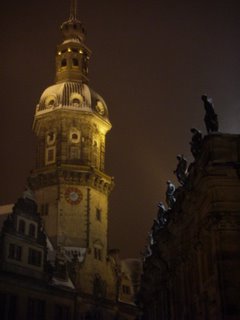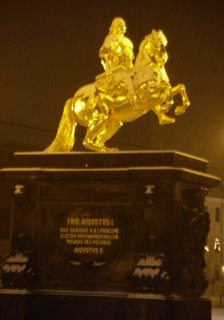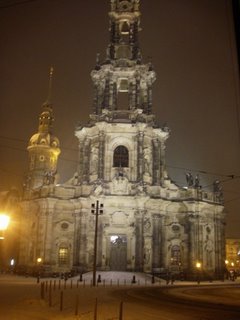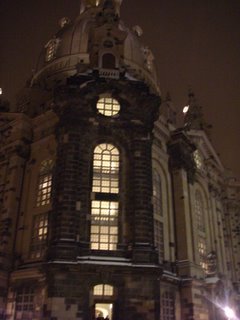The Altstadt in Dresden
After leaving Freiberg the plan was to get to Dresden, walk around the Altstadt before dinner and heading out drinking. However while snow looks lovely in photos it also slows driving down. So we ended up needing some "reviving" beers in the hostel before heading off. Which then turned into needing dinner as well. So after dinner we set off on our tour - this is now 9pm! - but the delay meant that a uni friend of Joerg's came along too. Which was excellent as "hes a real local - he knows everything about Dresden"!
So I caused the first (and possibly only) night walking tour of Dresden with tour guide Tomas pushing his bicycle through the snow and us all coping with temperatures around -10. He did indeed know everything e.g. the first skyscraper in Germany is near the edge of the Neustadt and was built in the 1920s. The other highlight of the tour was the refreshments - Claudia had been carrying a bottle of bubbly all day to celebrate the season - now it was used to stave off cold!
Dresden is the capital of Saxony and therefore contains the palaces of the royal family. The most famous of the Saxon Kings/Electors was Augustus the Strong - interestingly a guidebook described him as "particularily odious" yet nowhere in Saxony did he seem better or wose than anyone else, in fact he seems to have done a lot in terms of construction and empire-building (I suppose it depends whether you were with him or being opressed/invaded by him). 
 Augustus was the first King to convert back to Catholicism, not for any religious reasons but to increase his power - he realised he could not defeat Poland (Saxony and Prussia had been trying for years) but if he converted to Catholicism he could marry the daughter of the Polish King. The story is he was taking one for the boys - the rumour is she was no oil painting and in fact no paintings (oil or otherwise) exist to prove the rumour right or wrong (implying its true!). As a way to prove he was a devout Catholic he built an enormous Cathedral right next door to his palace (see below). It worked - he married her and became King of Poland, although his sons subsequently lost Poland to the Russians and converted back to Protestants.
Augustus was the first King to convert back to Catholicism, not for any religious reasons but to increase his power - he realised he could not defeat Poland (Saxony and Prussia had been trying for years) but if he converted to Catholicism he could marry the daughter of the Polish King. The story is he was taking one for the boys - the rumour is she was no oil painting and in fact no paintings (oil or otherwise) exist to prove the rumour right or wrong (implying its true!). As a way to prove he was a devout Catholic he built an enormous Cathedral right next door to his palace (see below). It worked - he married her and became King of Poland, although his sons subsequently lost Poland to the Russians and converted back to Protestants.
After the bombing of Dresden you could stand at the river and see 5-6kms of absolutely nothing. Since the war it has been rebuilt through a combination of public and private funding - one of the landmarks occurred this year with the finishing of the Frauenkirche, the Protestant Church of Our Lady and one of the first Protestant churches. You can google it and find out the religious significance but as a cultural symbol for Saxony and Germany it means a lot. The dark bricks below are bricks re-used from the original structure (which gives you an idea of the extent of the damage, pretty much nothing remained above 10m).  The reconstruction process began with the coming down of the wall and involved donations from nearly everyone in Germany. It was driven by the same feelings Ive seen earlier in Berlin and Hamburg, the feeling of guilt about the events that occurred, the feeling of shame that a nation so great could turn its enormous power to war, and the pain at having hurt others and themselves so much. The rebuilding is not about providing a tourist market or driven by religious pressures it represents the reconstruction of a country and of the heritage that existed before the war, it is an attempt to show that German national pride is nothing to be ashamed of but also its a memorial to what occurred. The patchwork nature of the building will cause children and tourists well into the future to ask why.
The reconstruction process began with the coming down of the wall and involved donations from nearly everyone in Germany. It was driven by the same feelings Ive seen earlier in Berlin and Hamburg, the feeling of guilt about the events that occurred, the feeling of shame that a nation so great could turn its enormous power to war, and the pain at having hurt others and themselves so much. The rebuilding is not about providing a tourist market or driven by religious pressures it represents the reconstruction of a country and of the heritage that existed before the war, it is an attempt to show that German national pride is nothing to be ashamed of but also its a memorial to what occurred. The patchwork nature of the building will cause children and tourists well into the future to ask why.
Our tour finished as logically as it started. At the Frauenkirche Tomas turned to me "We have no more alcohol and there is really nothing more to see. I think we should go back to a pub if you are happy you've seen enough". Who can argue with that?

No comments:
Post a Comment